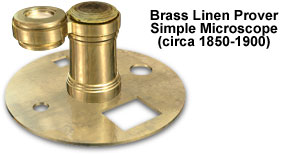Linen Prover Simple Microscope
In the mid-nineteenth century, textile merchants used standardized simple microscopes that were known as linen provers to ensure that linen weavers met specified fiber counts. Also known as counting glasses, the handy, pocket-sized magnifiers were sometimes used for other types of inspection work as well, including art verification and forensic science.

The brass linen prover presented above includes four different sized apertures or standard openings for estimating the density of weaving. Two of the holes are circular with 0.25-inch and 0.13-inch diameters, while the other two are square, one with 0.25-inch sides and the other with 0.50-inch sides. The focal length is fixed at 25 centimeters and a swing-out simple lens may be fixed over any of the four openings in the instrument's circular base. To determine the thread density of linen or other fabric, the simple microscope is placed on a piece of cloth and all threads within a chosen aperture are counted.
Gerard Turner describes this linen prover and another model from the Royal Microscopical Society collection in his book The Great Age of the Microscope. Turner estimates the unsigned linen provers are from the second half of the nineteenth century. Interestingly, several pioneers in microscopy, such as Dutch naturalists Pieter Cramer and Antonie van Leeuwenhoek, were linen or wool drapers originally and were first exposed to microscopes through the simple counting glass before moving on to exploring insects and other life forms with more advanced optical instruments.
BACK TO NINETEENTH CENTURY MICROSCOPES
